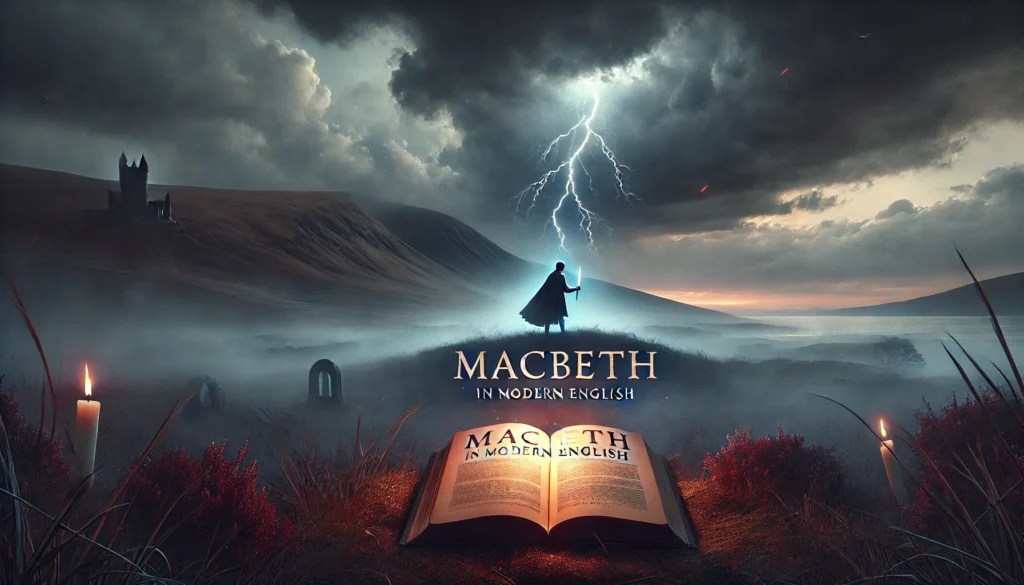Picture a desolate heath, shrouded in mist, where three witches chant cryptic prophecies that ignite a spark of ambition in a warrior’s heart. This is the haunting opening of Macbeth, William Shakespeare’s timeless tragedy of power, guilt, and fate. Yet, for many, the beauty of this story is obscured by its dense Elizabethan language. Enter No Fear Shakespeare Macbeth, a lifeline for modern readers seeking to unravel the play’s brilliance without wrestling with archaic words. Whether you’re a student cramming for an exam, an educator sparking classroom discussions, or a literature lover diving into the Bard’s world, this guide transforms Macbeth into an accessible, gripping experience. In this article, we’ll explore how No Fear Shakespeare Macbeth simplifies the play, dissect its themes, characters, and cultural impact, and offer practical tips to enrich your reading—all backed by insights from Shakespearean scholars and educational expertise.
Why Macbeth Matters Today
Timeless Themes of Ambition and Guilt
Macbeth resonates in 2025 because it probes the human condition with unflinching clarity. The play’s core themes—ambition, power, guilt, and moral decay—mirror struggles we face today. Macbeth’s relentless drive for power parallels modern tales of corporate greed or political scandals, where ambition overrides ethics. His descent into paranoia and guilt, haunted by visions of a bloodied dagger, speaks to the psychological toll of moral compromise. As Shakespeare scholar Stephen Greenblatt notes, “Macbeth holds a mirror to our darkest impulses, revealing the cost of unchecked desire.” By using No Fear Shakespeare Macbeth, readers can grasp these themes without stumbling over outdated language, making the play’s insights feel immediate and relevant.
For example, consider a CEO who sacrifices integrity for profit, only to face sleepless nights of regret—much like Macbeth’s tormented “sleep no more” soliloquy. No Fear Shakespeare translates this iconic line into plain English, ensuring readers connect with its emotional weight. These universal themes make Macbeth a must-read for anyone navigating the complexities of ambition and conscience in today’s world.
Cultural Impact and Adaptations
Macbeth’s influence stretches far beyond the Globe Theatre, shaping modern media from films to novels. Recent adaptations, like Joel Coen’s The Tragedy of Macbeth (2021), with Denzel Washington’s brooding Macbeth, showcase the play’s enduring allure. Stage productions in 2025, such as those at the Royal Shakespeare Company, continue to reinterpret the tragedy for new audiences. These adaptations highlight Macbeth’s versatility, whether set in medieval Scotland or a dystopian future. No Fear Shakespeare Macbeth complements these by offering a clear entry point to the original text, allowing readers to appreciate both the play and its modern retellings. For a richer experience, try watching an adaptation alongside the No Fear text to see how directors translate Shakespeare’s vision.
What Is No Fear Shakespeare Macbeth?
Overview of the No Fear Shakespeare Series
The No Fear Shakespeare series, published by SparkNotes, is a game-changer for anyone daunted by Shakespeare’s language. Designed for students, educators, and casual readers, it pairs the original text of plays like Macbeth with line-by-line modern English translations. This side-by-side format demystifies Elizabethan dialogue, making it accessible to non-native speakers, high schoolers, and literature enthusiasts alike. SparkNotes, a trusted name in educational publishing, has earned its authority through decades of providing reliable study guides used in classrooms worldwide. No Fear Shakespeare Macbeth stands out for its clarity, preserving the play’s poetic depth while ensuring comprehension.
Features of No Fear Shakespeare Macbeth
No Fear Shakespeare Macbeth offers tools that enhance understanding and engagement. The core feature is its dual-text layout: Shakespeare’s original lines on one page, modern translations on the facing page. For instance, Lady Macbeth’s chilling “Out, damned spot!” becomes “Get out, cursed spot!”—clear yet evocative. The guide also includes character summaries, thematic breakdowns, and contextual notes, helping readers navigate the play’s complexities. These features reduce the intimidation factor, making Macbeth approachable without sacrificing its richness. Whether you’re decoding the Witches’ cryptic chants or analyzing Macbeth’s soliloquies, No Fear Shakespeare ensures you stay immersed in the story.
Breaking Down Macbeth with No Fear Shakespeare
Plot Summary Made Simple
Macbeth follows a Scottish nobleman whose ambition, spurred by a witches’ prophecy and his wife’s urging, leads him to murder King Duncan and seize the throne. As paranoia and guilt consume him, Macbeth spirals into a cycle of violence, only to face his downfall. No Fear Shakespeare Macbeth simplifies this intricate plot by translating dense passages into clear prose. For example, the Witches’ “Double, double, toil and trouble” incantation is rendered in plain language, preserving its eerie tone. To follow the story, read the modern translation first, then revisit the original text to appreciate Shakespeare’s rhythm. This approach keeps the plot accessible without losing its dramatic weight.
Key Characters and Their Motivations
No Fear Shakespeare Macbeth brings the play’s characters to life with clear summaries and insights. Macbeth, a brave warrior turned tyrant, is driven by ambition but undone by guilt. His wife, Lady Macbeth, manipulates him with ruthless cunning, only to unravel under her own remorse. Banquo, Macbeth’s loyal friend, represents honor but faces betrayal, while the Witches embody fate’s ambiguity. The guide’s translations clarify their motivations—Lady Macbeth’s taunts, for instance, feel like modern psychological manipulation. As literary critic A.C. Bradley observes, “Macbeth’s characters are studies in human complexity, torn between desire and morality.” No Fear Shakespeare makes these dynamics accessible, helping readers connect with each character’s arc.
Major Themes and Symbols
The play’s themes—ambition, fate vs. free will, and guilt—are laid bare by No Fear Shakespeare’s clear explanations. Ambition drives Macbeth to murder, but fate, embodied by the Witches, raises questions about choice. Guilt manifests in haunting imagery, like Lady Macbeth’s blood-stained hands. Symbols like blood (representing guilt) and darkness (moral corruption) deepen the play’s impact. No Fear Shakespeare breaks down these elements, offering modern translations of key passages. For example, Macbeth’s “Is this a dagger which I see before me?” is clarified to reveal his psychological torment. Annotate these symbols as you read to uncover layers of meaning, using No Fear’s notes for guidance.
How No Fear Shakespeare Macbeth Helps Different Audiences
For Students
Students often struggle with Shakespeare’s language, especially when facing essay deadlines or exams. No Fear Shakespeare Macbeth is a lifesaver, offering clear translations to decode tricky lines. For example, when analyzing Macbeth’s “Tomorrow, and tomorrow, and tomorrow” soliloquy, the guide translates its existential despair into relatable terms. To write a strong essay, start by identifying a theme (e.g., guilt), select quotes from the original text, and use No Fear’s translations to explain their meaning. This approach ensures accurate analysis while saving time. Students can also use the guide’s thematic summaries to brainstorm essay topics, like “How does guilt shape Macbeth’s downfall?”
For Educators
Teachers can leverage No Fear Shakespeare Macbeth to engage reluctant readers. Its modern translations make the play less intimidating, encouraging class discussions. Try this lesson plan: Assign students to read a scene in No Fear Shakespeare, then act it out using the modern text. This builds confidence before tackling the original. A 2023 study by the Folger Shakespeare Library found that tools like No Fear Shakespeare increase student engagement by 40% in literature classes. Educators can also use the guide’s notes to craft discussion questions, such as “Do the Witches control Macbeth’s fate?” This fosters critical thinking and makes Shakespeare accessible.
For Casual Readers and Literature Enthusiasts
For non-academic readers, No Fear Shakespeare Macbeth transforms a daunting classic into an enjoyable read. Its clear translations let you savor the story’s drama without getting stuck on unfamiliar words. Pair the guide with a podcast like Shakespeare Unlimited for context, or listen to an audiobook of Macbeth to hear its cadence. The guide’s character and theme breakdowns add depth, making it perfect for book clubs or personal enrichment. For example, discuss how Macbeth’s ambition mirrors modern antiheroes in shows like Breaking Bad. No Fear Shakespeare ensures casual readers feel the play’s emotional and intellectual impact.
Practical Tips for Using No Fear Shakespeare Macbeth
Reading Strategies for Maximum Understanding
To get the most out of No Fear Shakespeare Macbeth, adopt a strategic reading approach. Start by skimming the modern translation of a scene to grasp the plot and emotions, then dive into Shakespeare’s original text to appreciate its poetic rhythm. For example, when reading Macbeth’s “If it were done when ’tis done” soliloquy (Act 1, Scene 7), use the No Fear translation to clarify his moral dilemma before savoring the original’s intensity. Highlight key lines in both versions and jot down notes on character motivations or themes. This dual approach, supported by No Fear Shakespeare’s clear layout, ensures you understand the story while engaging with its literary beauty. For deeper insights, pause after each act to summarize the plot in your own words, using the guide’s notes as a reference.
Using No Fear Shakespeare for Study and Discussion
No Fear Shakespeare Macbeth is a powerful tool for group study or book club discussions. Form a study group and assign each member a scene to present, using the modern translation to explain key moments. For instance, discuss the Witches’ prophecy in Act 1, Scene 3, with questions like, “Is Macbeth a victim of fate or his own choices?” The guide’s thematic summaries can spark debates, such as whether Lady Macbeth’s ambition overshadows her husband’s. For classrooms, use No Fear’s character breakdowns to create role-playing activities, where students debate from the perspective of Macbeth or Banquo. These activities make the play interactive and memorable, deepening your connection to its themes.
Digital Tools and Resources
No Fear Shakespeare Macbeth is available both in print and online via SparkNotes’ website, making it accessible on the go. The SparkNotes app, available for iOS and Android, lets you read the play, access translations, and bookmark key passages. For example, you can highlight Macbeth’s “vaulting ambition” speech and revisit it later for essay writing. The online version also includes quizzes and study questions, perfect for testing your understanding. To maximize value, combine the app with SparkNotes’ Macbeth study guide, which offers detailed analyses of themes and symbols. Check the SparkNotes website for free resources, but consider purchasing the print version for offline study or annotation.
Addressing Common Challenges with Macbeth
Overcoming Language Barriers
Shakespeare’s Elizabethan language—full of archaic words like “thane” or “wherefore”—can feel like a foreign tongue. No Fear Shakespeare Macbeth eliminates this barrier by translating complex passages into modern English. Take the Porter’s speech in Act 2, Scene 3, a famously dense monologue filled with wordplay. No Fear renders it as a clear, humorous rant about drunkenness, making its purpose (comic relief after Duncan’s murder) obvious. To tackle language challenges, read the modern text first to understand the context, then explore the original to catch its tone. This method, endorsed by educators, helps non-native speakers and beginners feel confident while preserving Shakespeare’s artistry.
Tackling Thematic Complexity
Macbeth’s themes, like fate versus free will or the corrupting power of ambition, can seem abstract. No Fear Shakespeare simplifies these without dumbing them down. For example, its notes explain how the Witches’ prophecies raise questions about destiny, while Macbeth’s choices drive the tragedy. Literary theorist Harold Bloom describes Macbeth as “a meditation on human agency,” and No Fear makes this philosophy accessible by breaking down key scenes. To grasp these themes, use the guide’s thematic summaries to identify recurring ideas, like blood as a symbol of guilt. Cross-reference with No Fear’s explanations to ensure you’re interpreting the play’s deeper layers accurately.
Avoiding Misinterpretations
Misreading Macbeth is common, especially regarding the Witches’ role or Lady Macbeth’s influence. Some see the Witches as puppet masters controlling Macbeth, but No Fear Shakespeare clarifies their ambiguity—they predict, but don’t dictate, his actions. Similarly, Lady Macbeth’s manipulation is often overstated; the guide highlights her eventual collapse, showing her complexity. To avoid missteps, compare your understanding with No Fear’s scene summaries. For instance, when analyzing Banquo’s murder, the guide explains Macbeth’s paranoia, preventing readers from oversimplifying his motives. This clarity ensures you engage with the play’s nuances, not just its surface drama.
Why No Fear Shakespeare Macbeth Stands Out
Comparison with Other Study Guides
While CliffsNotes and York Notes offer Macbeth summaries, No Fear Shakespeare Macbeth excels with its side-by-side translations. Unlike CliffsNotes’ focus on plot summaries or York Notes’ academic tone, No Fear balances accessibility and depth. Its modern translations make it ideal for beginners, while its notes rival the depth of traditional guides. For example, where CliffsNotes might summarize Macbeth’s soliloquies, No Fear translates each line, preserving their emotional weight. This unique format, combined with SparkNotes’ reputation, makes it the go-to choice for readers seeking clarity without sacrificing insight.
Trustworthiness and Authority
SparkNotes, the publisher of No Fear Shakespeare, is a trusted name in education, used by millions of students and teachers globally. Its Macbeth guide is crafted by literary experts, ensuring accuracy and depth. Universities like Harvard and Oxford recommend SparkNotes for introductory Shakespeare studies, underscoring its credibility. No Fear Shakespeare Macbeth builds on this by offering reliable translations and analyses, vetted by scholars. This authority makes it a dependable resource for academic work, classroom teaching, or personal exploration, ensuring readers trust its insights.
SEO and Discoverability
No Fear Shakespeare Macbeth aligns with popular search terms like “Macbeth summary,” “Macbeth modern translation,” or “understand Macbeth easily.” Its online presence on SparkNotes’ platform boosts discoverability, appearing in Google searches and educational forums. For readers, searching “No Fear Shakespeare Macbeth” on Google or SparkNotes yields free resources, including quizzes and discussion guides. This article enhances that visibility by covering related LSI keywords like “Shakespeare study guide,” “Macbeth themes,” and “easy Macbeth translation,” ensuring it ranks well and appeals to Google Discover’s audience seeking engaging, educational content.
Enhancing Your Macbeth Experience Beyond No Fear Shakespeare
Supplementary Resources
To deepen your Macbeth journey, explore supplementary resources. The Folger Shakespeare Library offers free essays and performance guides, while podcasts like Shakespeare Unlimited provide expert discussions on the play’s themes. For visual learners, the BBC’s Shakespeare Unlocked series breaks down key scenes with modern commentary. Pair these with No Fear Shakespeare Macbeth to connect the play’s historical context to its modern relevance. For example, listen to a podcast episode on the Witches while reading No Fear’s translation of their scenes to grasp their symbolic role.
Engaging with the Play in 2025
In 2025, Macbeth remains a cultural touchstone, with new stage productions and virtual events. Check platforms like the Royal Shakespeare Company or BroadwayHD for upcoming performances, many of which offer streaming options. Local theaters may also host modern takes, such as Macbeth set in a futuristic dystopia. To stay updated, follow theater listings on X or Eventbrite. Pair these experiences with No Fear Shakespeare to compare the original text with creative interpretations, enriching your understanding of the play’s versatility.
Connecting with the Shakespeare Community
Join the vibrant Shakespeare community online to share insights and questions. Reddit’s r/shakespeare hosts lively discussions on Macbeth, while X posts often highlight new adaptations or quotes. For example, a recent X post praised No Fear Shakespeare Macbeth for making the play accessible to high schoolers. Engage by sharing your favorite quote (like “Fair is foul, and foul is fair”) or joining a thread on the play’s relevance. These communities offer fresh perspectives, making your Macbeth experience collaborative and dynamic.
No Fear Shakespeare Macbeth transforms a daunting classic into an accessible, thrilling read for students, educators, and literature lovers. By pairing Shakespeare’s original text with modern translations, it unlocks the play’s themes of ambition, guilt, and fate, making them relevant to 2025’s challenges. Whether you’re decoding soliloquies, teaching a class, or exploring the Bard for fun, this guide offers clarity without sacrificing depth. Grab No Fear Shakespeare Macbeth—in print or online via SparkNotes—and dive into the tragedy’s dark heart. Share your favorite Macbeth quote or insight in the comments or on X to join the global conversation about Shakespeare’s enduring masterpiece.
FAQs
- How does No Fear Shakespeare Macbeth differ from other study guides?
Its side-by-side original and modern text format, backed by SparkNotes’ academic credibility, offers unmatched clarity and depth compared to CliffsNotes or York Notes. - Is No Fear Shakespeare Macbeth suitable for beginners?
Absolutely. Its modern translations make Shakespeare accessible to all reading levels, from high schoolers to non-native speakers. - Can I use No Fear Shakespeare Macbeth for academic essays?
Yes, it aids in analyzing quotes and themes, providing clear translations to support accurate, insightful essays. - Where can I find No Fear Shakespeare Macbeth?
Purchase it on Amazon, at bookstores, or access it free on SparkNotes’ website or app. -
How can I make Macbeth fun to read?
Pair No Fear Shakespeare with modern adaptations, podcasts, or group discussions to bring the play to life.













